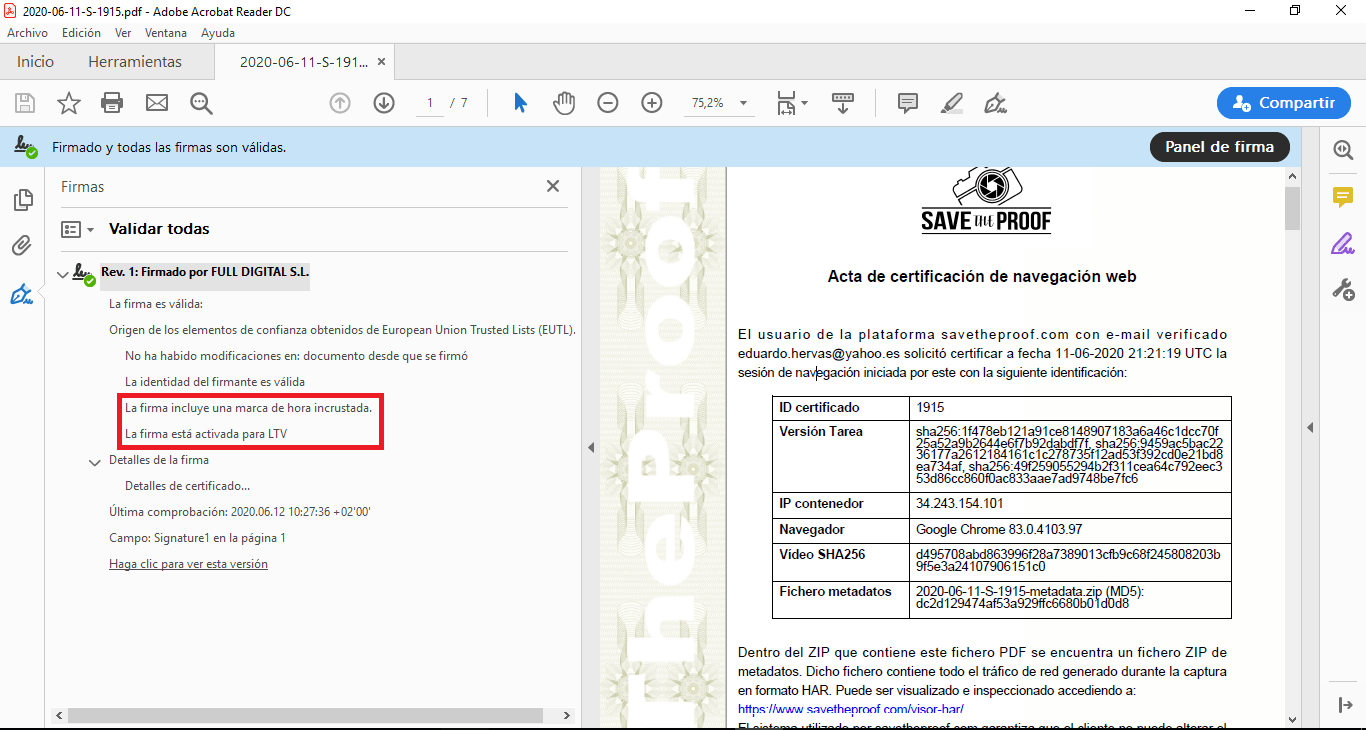
Legal Validity of SaveTheProof.com
Why is certifying digital evidence so important?
When dealing with digital evidence, you may encounter multiple problems that you should avoid in order to give legal validity to your eveidence:
What does “Legal Validity” mean?
Electronic documents generated by SaveTheProof are considered private documents, in accordance with Article 324 of the Civil Procedure Law. Therefore, they will constitute full proof in a judicial procedure as established by Article 326 of the Civil Procedure Law, provided their authenticity is not challenged (See the section “What to do if a SaveTheProof document is challenged?”)
SaveTheProof generates an electronic document to attest, as an independent and impartial third party, the content of a webpage or file at a specific point in time. This document is signed with an advanced electronic signature with a qualified timestamp in accordance with the European regulation eIDAS. This ensures the authenticity, integrity, and non-repudiation of the document generated by SaveTheProof. Additionally, it includes additional technical information (metadata) that strengthens the legal validity of the certificates.
The digital signature
Equivalent to a handwritten signature, the digital signature is linked to the PDF certificate, and its basic functions are:
The savetheproof.com platform uses an advanced electronic signature in accordance with the European eIDAS regulation provided by a recognized certification authority: https://www.firmaprofesional.com


Qualified timestamp
A timestamp linked to the PDF certificate unequivocally guarantees the date when the certificate was generated. The savetheproof.com platform uses the qualified timestamping service (TSA) in accordance with the eIDAS regulation, provided by: https://www.izenpe.com

Metadata
In addition to the digital signature and timestamp, all documents (certificates) issued by SaveTheProof.com incorporate a set of additional technical information (metadata). The metadata provides greater legal robustness to the certificates and includes information such as:

Does SaveTheProof guarantee the admission of the evidence?
The admission of evidence by the courts doesn’t only depend on the authenticity of the evidence. There are other criteria evaluated by judges to determine what can be introduced in the proceedings, such as whether it is necessary evidence, suitable for resolving the matter, or whether it has been submitted within the corresponding timeframe. However, these criteria depend solely on the expertise or knowledge of the party that has provided them. SaveTheProof can only certify that a certain digital content exists or existed and that its content is as reproduced.
The probative value of the provided certificate will depend solely on the judge, who, along with the rest of the evidence presented, will issue a ruling.
As a guide, you can review the admissibility of evidence with a Digital Signature by Country and its exclusions.
The Tuenti Judgment – Establishing Criteria
On May 19, 2015, the Criminal Chamber of the Supreme Court issued judgment 300/2015, better known as the Tuenti Judgment. In this judgment, criteria were established regarding digital evidence, as, in the words of the judgment itself, this type of evidence “must be approached with all due caution.”
It is worth noting that this caution is due to the ease with which evidence can be manipulated and, therefore, displaying its fragility.
Furthermore, this judgment introduces what is called a reversal of the burden of proof for this type of evidence: “Therefore, challenging the authenticity of any of these conversations, when they are brought to the case through print files, shifts the burden of proof to the party seeking to take advantage of their probative value.”
This implies that whoever has submitted the evidence and aims to prove their version of events, in the event the evidence is challenged, will have to demonstrate the authenticity of the evidence. Additionally, it will require an expert report: “In such a case, it will be essential to conduct an expert examination that identifies the true origin of that communication, the identity of the speakers, and, in short, the integrity of its content.”
In summary, when you submit evidence in court, you must ensure that in case it is challenged, you can demonstrate through an expert report that the evidence is authentic. A screenshot will not allow you to prove this authenticity. In contrast, if you have certified the content through SaveTheProof, any expert can verify that the certified content is authentic since it is electronically signed, timestamped, and includes all the technical information we provide along with the certificate.
What happens if a SaveTheProof document is challenged?
Article 326 of the Civil Procedure Law regarding private documents establishes that when a document is contested, the party presenting it may propose any means of proof to prove its authenticity. The costs and expenses incurred in proving authenticity will be solely borne by the party contesting the evidence.
Savetheproof can attest to:
As seen, documents generated by SaveTheProof easily allow for proving their authenticity, integrity, and non-repudiation. This serves as a deterrent effect when contested by the other party, as it involves facing the costs and expenses of the challenge once its authenticity is established.


















